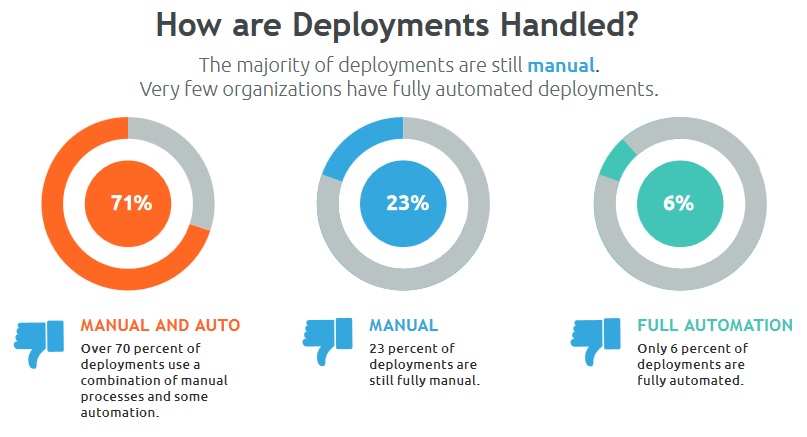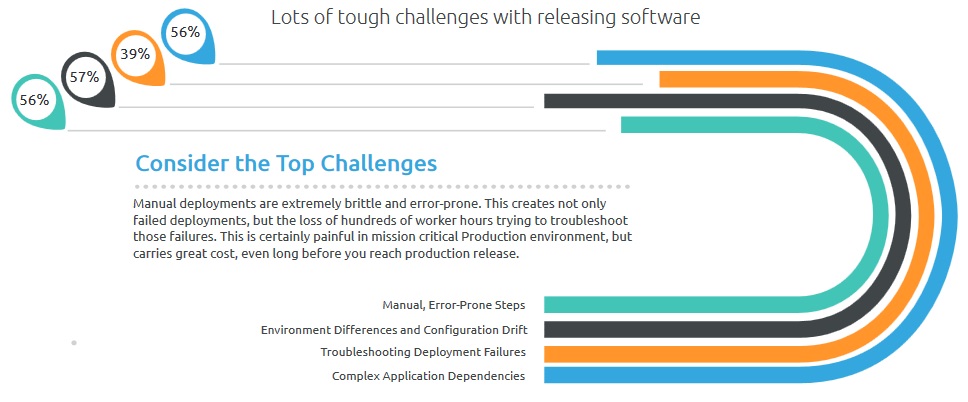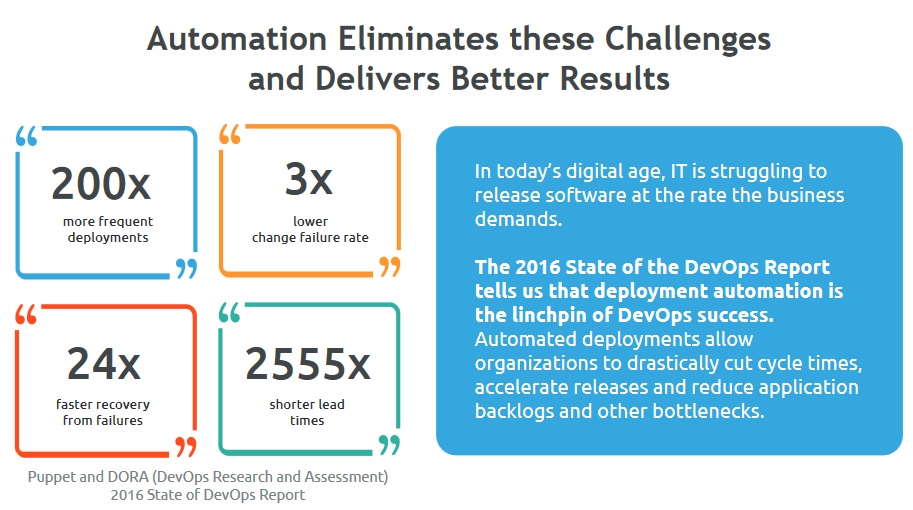mabl announced the addition of mobile application testing to its platform.
There might be many people across organizations who claim that they’re using a DevOps approach, but often times, the “best practices” they’re using don’t align with DevOps methodologies. They can say what they do is “DevOps”, but what we’ve found is that many are actually not following basic agile methodology principles, and that’s not DevOps. Ever.
How Are We So Sure?
Electric Cloud gathered data from thousands of engineers and IT leaders across three major events – DOES 2016, Agile 2016 and Appshere 2016 (and compared it with specific data sets from the Puppet and DORA 2016 State of the DevOps Report) – asking them about their deployment and application release automation practices, and we found some interesting patterns.
For starters, the data show us that the majority of deployments are still manual. Specifically, over 70 percent of deployments use a combination of manual processes and some automation. While many think, in this instance, that they are automating their releases, this isn’t automation. Just because you’re using a Chef recipe to automate one of your releases, doesn’t mean you’re an automated shop.

It Gets Worse
The two remaining datasets from this section tells us perhaps the most disappointing fact – 23 percent of deployments are still fully manual and only 6 percent of deployments are fully automated. Let’s face it; manual intervention often leads to errors and non-repeatable processes. No bueno. If testing or deployments are handled manually, it’s nearly impossible to implement continuous delivery or continuous integration in any way. What this statistic tells us is that many don’t realize that they have increased the risk of defects to their software (which almost always creates unplanned workloads), or a higher risk of deployments failing all together.
When relying on manual processes versus automation, an entire host of problems can emerge. The top challenges with manual deployments are:
1. Environment differences and configuration drift
2. Manual, error-prone steps
3. Complex application dependencies
4. Manual deployments often lead to more time spent troubleshooting deployment failures
The bottom line is this: manual deployments are extremely brittle and error-prone. This creates not only failed deployments, but also the loss of hundreds of worker hours trying to troubleshoot those failures. This is certainly painful in mission critical production environments, but carries great cost, even long before you reach production release.

The Bigger Truth
As surprising as it might be to read in 2017, IT departments are still struggling to release software at the rate the business demands. As we see from the Puppet and DORA 2016 State of the DevOps Report, automation eliminates common challenges that come with manual deployments, and delivers better results.
Deployment automation is the linchpin of DevOps success. Automated deployments allow organizations to drastically cut cycle times, accelerate releases and reduce application backlogs. Specifically, according to the Puppet and DORA Report, automation provides 200x more frequent deployments, 3x lower change failure rates, 24x faster recovery from failures and 2555x shorter lead times.

Deployment Automation is the Linchpin of DevOps Success
DevOps is not the responsibility of one person or one team. It’s a company mindset that when set in motion, delivers immediate value. The right Application Release Automation solution can dramatically accelerate your time-to-market and cycle times, give you confidence in your IT operations, enhance teamwork, and reduce operational costs.
Industry News
Spectro Cloud announced the achievement of a new Amazon Web Services (AWS) Competency designation.
GitLab announced the general availability of GitLab Duo Chat.
SmartBear announced a new version of its API design and documentation tool, SwaggerHub, integrating Stoplight’s API open source tools.
Red Hat announced updates to Red Hat Trusted Software Supply Chain.
Tricentis announced the latest update to the company’s AI offerings with the launch of Tricentis Copilot, a suite of solutions leveraging generative AI to enhance productivity throughout the entire testing lifecycle.
CIQ launched fully supported, upstream stable kernels for Rocky Linux via the CIQ Enterprise Linux Platform, providing enhanced performance, hardware compatibility and security.
Redgate launched an enterprise version of its database monitoring tool, providing a range of new features to address the challenges of scale and complexity faced by larger organizations.
Snyk announced the expansion of its current partnership with Google Cloud to advance secure code generated by Google Cloud’s generative-AI-powered collaborator service, Gemini Code Assist.
Kong announced the commercial availability of Kong Konnect Dedicated Cloud Gateways on Amazon Web Services (AWS).
Pegasystems announced the general availability of Pega Infinity ’24.1™.
Sylabs announces the launch of a new certification focusing on the Singularity container platform.
OpenText™ announced Cloud Editions (CE) 24.2, including OpenText DevOps Cloud and OpenText™ DevOps Aviator.
Postman announced its acquisition of Orbit, the community growth platform for developer companies.
Check Point® Software Technologies Ltd. announced new email security features that enhance its Check Point Harmony Email & Collaboration portfolio: Patented unified quarantine, DMARC monitoring, archiving, and Smart Banners.




